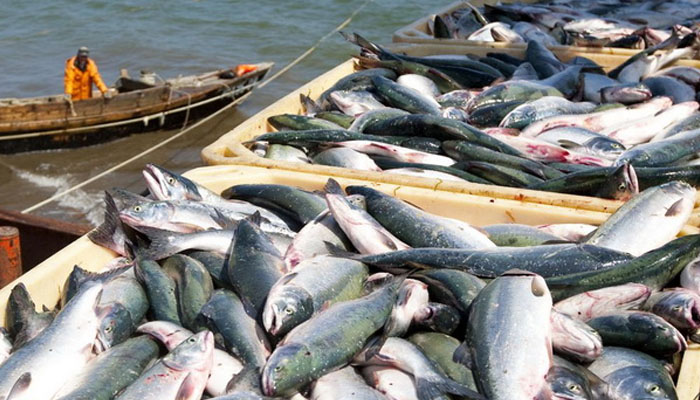Pakistan fish exports up 27.94pc, netting $451.026 million in FY18
Pakistan’s seafood exports have increased 27.94 percent to 198,420 tons fetching $451.026 million for the national exchequer in fiscal year 2017-18, according to market officials.
KARACHI: Pakistan’s seafood exports have increased 27.94 percent to 198,420 tons fetching $451.026 million for the national exchequer in fiscal year 2017-18, according to market officials.
The country’s export value increased 14.57 percent from $393.662 million off 155,091 tons in 2016-17. However, as per officials, the country’s fisheries exports declined 7.35 percent in value to $11.837 million tons in July 2018 from $12.776 million in the same month last fiscal. The quantity was down 2.87 percent to 5,452 tons from 5,613 tons.
Industry stakeholders complain that Pakistani seafood fetches lower value in the international market as the quantity of exportable fish has depleted due to various reasons, including overfishing.
Faisal Iftikhar, former president, Pakistan Fisheries Exporters Association, said, “Pakistan’s fish and fish preparations exports fetch $2.27 to $2.5 per kilogram, which is lowest in the region’s average price of around $7/kg.”
He blames it on the lower quality of fish meal. “Our prices show that we export more fish meal and our prices are lower than quality fish meal price, which fetches $3/kg.”
He said quality seafood stocks were depleting in Pakistani waters because of overfishing and use of destructive nets. Pakistan mostly exports to China at lower rates, although the European Union has lifted ban from two factories amid political pressure, ‘without inspecting the factories on the ground”, he informed.
“Revival of exports to EU had no significant impact over Pakistan’s total seafood exports,” the official said, adding that only one factory exported to EU, and that too on lower prices at par with China.
China is one of the largest buyers of Pakistan’s fish and fish preparations. Other buyers include Hong Kong, Indonesia, Egypt, Middle East, UK, Thailand, South Korea, Bangladesh etc.
Capt Akhlaque, whose factory is the only one exporting seafood to EU, said, “We are not in a bargaining position. India is controlling the prices, with 200 factories exporting to the European Union countries.”
According to Marine Fisheries Department, there are around 150 fish and seafood exporting firms in Pakistan, of which 35 operate in the premises of Karachi Fish Harbour.
Akhlaque said commercial fish stocks had not depleted completely. “When ban on fishing is fully implemented during the breeding season in June and July, better stocks develop,” he said, adding that since the ban was implemented there were chances of better fishing in the current fiscal year.
Muhammad Ali Shah, chairmen Pakistan Fisherfolk Forum, a representative body of fishermen, said processing and transportation of fish to the harbour was poor, which deteriorated the fish quality resulting in lower prices in the international market.
“Fish caught at Keti Bunder is transported to Karachi Fish Harbour in a poor manner, which deteriorates its quality,” he added.
Shah said that deep-sea fishing and overfishing had affected the commercial fish stocks, which were rapidly reducing in Pakistani waters. “Marine pollution and use of harmful nets are increasing the woes,” he added.
The Fisheries Resources Appraisal in Pakistan Project, a Unilateral Trust Fund project of the Food and Agriculture Organization of the UN and the government of Pakistan have also pointed to depletion of seafood resources.
“The overall status for all the major fish stocks of Pakistan is that they are all below target biomass levels and nine of the species groups are below the depleted threshold,” said the project report. “Only two species groups out of 14 show any indication that fishing mortality is at or below the limit. All of Pakistan's marine fisheries are over-exploited.”
The report said the prospects for an economically vibrant and growing fishery were poor, and reduced exports, value, and food fish production were all to be expected even as fish meal production increases.
Over fishing is the major cause behind depletion of fish resources. In the 1980s it was estimated that the fleet was approximately 6,500 vessels and it is now over 11,500. In the 1980s it was judged that 550 shrimp trawlers would be sufficient to economically harvest the shrimp. Now, there are over 2,400 trawlers, most have switched from shrimp to 'trash' fishing as a result of the depleted stocks, and more are still being built.
“It is recommended that policy and regulatory steps be taken to reduce the fleet size overall to less than 6,000 vessels and the trawler fleet should be specifically limited to less than 600 out of the total,” recommended the project findings.
-
 ASAP Rocky Recalls 'embarrassing' First Meeting With Rihanna
ASAP Rocky Recalls 'embarrassing' First Meeting With Rihanna -
 Archie, Lilibet’s Chances At Meeting King Charles Get Promising Update: Here’s Why
Archie, Lilibet’s Chances At Meeting King Charles Get Promising Update: Here’s Why -
 Claire Foy Shares Rare Views On Typecasting Amid New Gig
Claire Foy Shares Rare Views On Typecasting Amid New Gig -
 Britney Spears Raves About Madonna In New Social Media Post
Britney Spears Raves About Madonna In New Social Media Post -
 Hailey Bieber Shares Sweet Snap Of Husband And Baby
Hailey Bieber Shares Sweet Snap Of Husband And Baby -
 Therapist Killed In Office As Former Client Launches Knife Attack
Therapist Killed In Office As Former Client Launches Knife Attack -
 Gaten Matarazzo Brands 'Stranger Things' Final Scene 'nerve-racking'
Gaten Matarazzo Brands 'Stranger Things' Final Scene 'nerve-racking' -
 David Beckham Speaks Out After Son Brooklyn Beckham's Shocking Post
David Beckham Speaks Out After Son Brooklyn Beckham's Shocking Post -
 Sophie Turner Gets Candid About 'imposter Sydrome' Post 'GOT'
Sophie Turner Gets Candid About 'imposter Sydrome' Post 'GOT' -
 When Nicola Peltz's Boyfriend Anwar Hadid Found Solace In Dua Lipa's Arms
When Nicola Peltz's Boyfriend Anwar Hadid Found Solace In Dua Lipa's Arms -
 Claire Foy Reveals Rare Impact Of 'The Crown' Gig On Career
Claire Foy Reveals Rare Impact Of 'The Crown' Gig On Career -
 Megan Thee Stallion Teases New Music On The Way
Megan Thee Stallion Teases New Music On The Way -
 Blonde Kate Stuns In Photos With Prince William During Rare Joint Engagement
Blonde Kate Stuns In Photos With Prince William During Rare Joint Engagement -
 Kate Gosselin Reveals Harrowing Moment Thief Nearly Took Her Down
Kate Gosselin Reveals Harrowing Moment Thief Nearly Took Her Down -
 Billy Bob Thornton Weighs In On Contrast To 'Landman' Role
Billy Bob Thornton Weighs In On Contrast To 'Landman' Role -
 Amanda Holden May Swap Position To Different Reality Show: See Which
Amanda Holden May Swap Position To Different Reality Show: See Which




